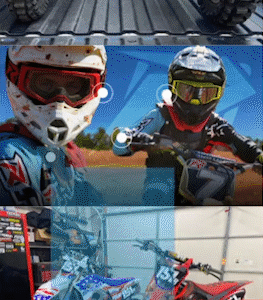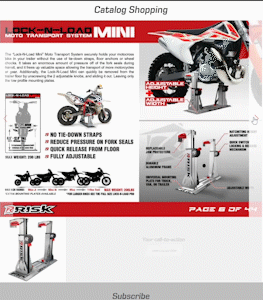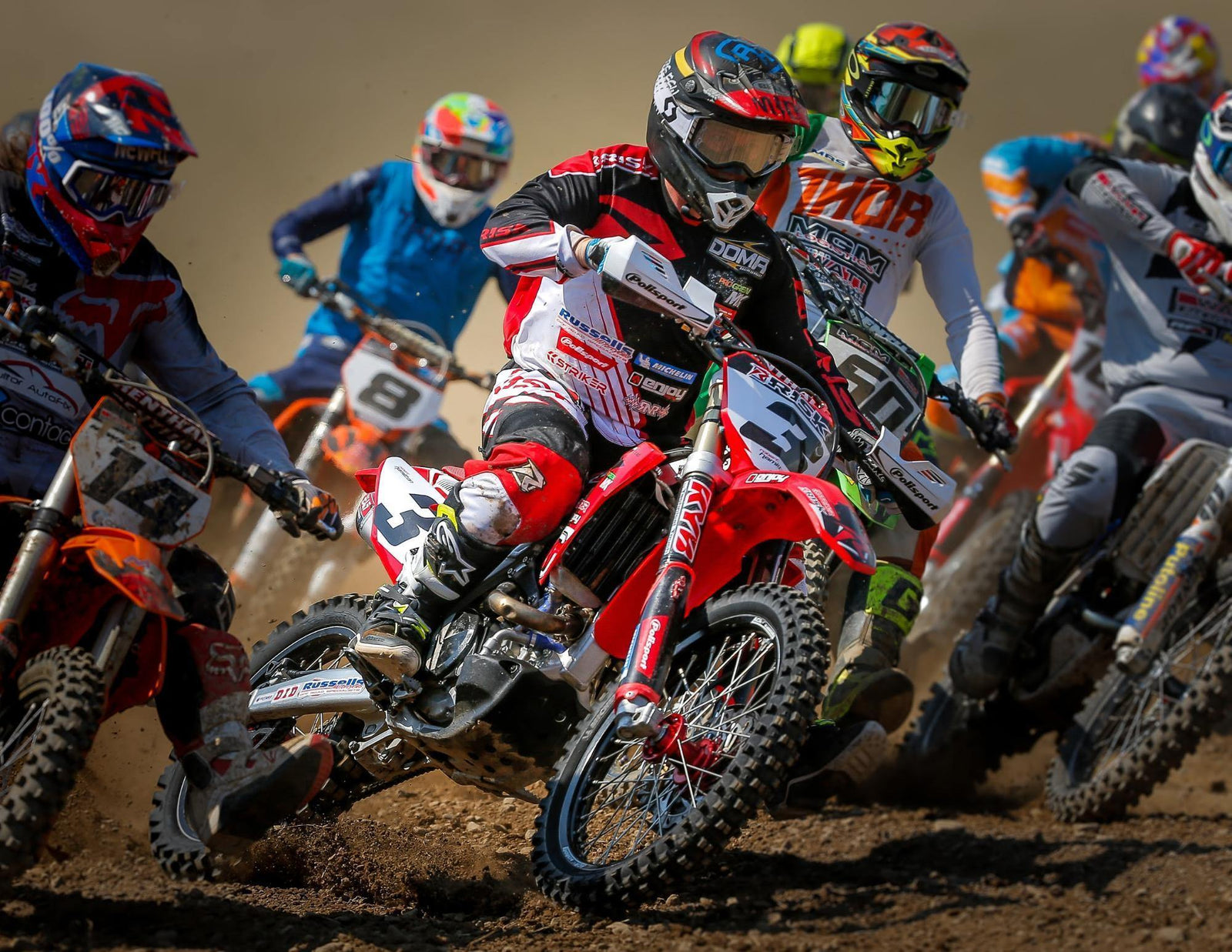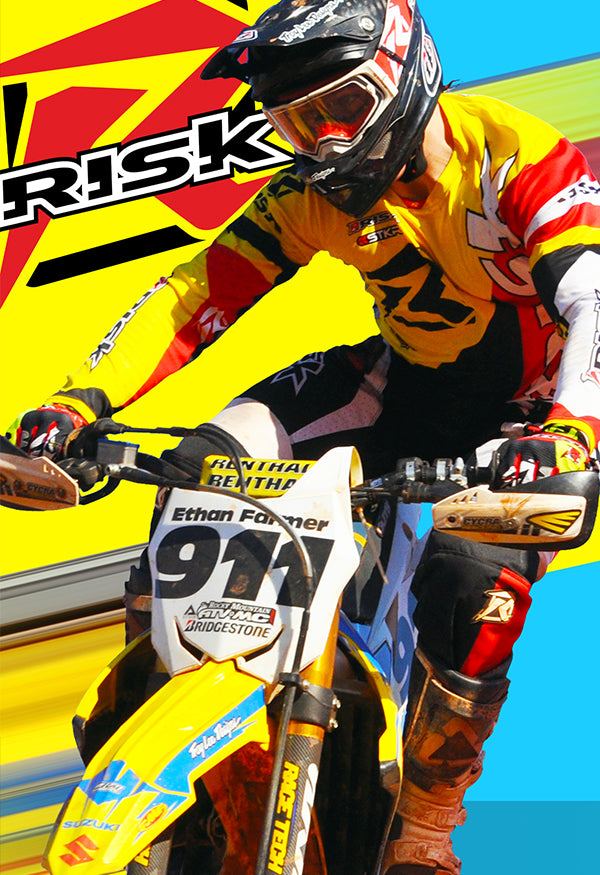Your Cart is Empty
MOTO Products
shop your way
Choose a shopping experience
Same great Risk Racing products, 3 completly different ways to shop them.
Choose a shopping experience
Same great Risk Racing products, 3 completly different ways to shop them.

Lifestyle Shopping

eComm Shopping

Catalog Shopping
MOTO TYRES
MOTO Gear & Apparel
What Is Motocross?
July 18, 2020 14 min read

Motocross is a motorcycle-based phenomenon that has been receiving more attention as the years have gone on - but what is it?
Motocross is a racing sport where participants ride motorcycles over rough terrain. The courses have to be one to three miles long, and they need to have different obstacles for the riders. No two courses are alike, and that can make motocross more demanding than other racing sports.
Whether you want to start doing motocross or want to watch, you should know what it involves. Then, you can learn what to do to win a race and how to be safe. If you prefer to watch, you can learn what to look for to see who is winning.
| Contents | |
|---|---|
| 1 | Overview of a Motocross Race |
| 2 | Health and Safety |
| 3 | What to Wear |
| 4 | Conclusion |
Overview of a Motocross Race
In motocross, participants race on motorcycles, and they navigate a course with different types of terrain. If someone can ride a motorcycle on the road, they may or may not be successful in motocross. However, riding a motorcycle on any surface can make it easier to start motocross.
While you may be able to hop on a motorcycle for a ride around town, preparing for a race involves a lot more than that. You have to consider how long the race is and the various obstacles you may encounter.
Motocross is the second most physically demanding sport in the world, so it takes a lot of physical and mental training, and you may not always know what to expectduring a race. Even in Supercross, an indoor version, the course can be complicated, and track conditions are constantly changing.
Here are a few factors that can affect the conditions of a motocross race:
Course Length
No two motocross tracks are the same, but they do have to follow some standards. International competitions must use tracks that are 1 to 3 miles (1.5 to 5 kilometers) long.
Many races take less than 40 minutes for each heat, and you will have two heats in a race. Overall, a motocross race would take less than two hours to complete.
The course width can also vary, but it is usually wide enough to accommodate a few racers side to side. However, the course is narrow enough to make turns somewhat difficult.

Turns
While different motocross courses have unique turns, they all have some sort of turn involved. The turns can make the course more difficult, and it requires the racers to anticipate their next steps.
Some courses may have sharper turns, while others may be more forgiving. Most courses will also have both left and right turns.
If you’re preparing for a motocross race, you should practice turning in both directions. You should also work on fast sweeping turns and slow tight turns to understand what you need to do.
As you start training, be sure to take it slowly with your turns. Motocross is a dangerous sport, and you don’t want to get yourself hurt before you race. Instead, have someone knowledgeable train you and teach you how to navigate different turns properly.
Riding motocross is a lot about riding position, weight distribution, and correct form. Learning correct form, in the beginning, can save a lot of time correcting bad habits in the end.

Hills
Another common feature of a motocross race is hills, and like turns, the hills vary. Not only will they vary by the course, but you can expect both uphill and downhill sections in a single race. You need to be able to work with both options.
Some motocross courses have very steep hills, but easier courses may have less of an incline. Either way, you should be able to operate your bike to make it up any big hills. You’ll also need to know how to safely get down a big hill.
Consider practicing on smaller hills then slowly working your way up and down bigger inclines. Then, you can use that experience when you encounter a hill on your next motocross race. Just like cornering, proper form and weight distribution is an important part of riding hills as well.

Jumps
Of course, jumps and jumping is a major aspect of riding and racing motocross. Each course will be filled with many different style jumps ranging from table tops, doubles, and even triple jumps. Start with mellow table top jumps that don’t send the rider high or far. When you get comfortable jumping, move up to larger table tops.
When you perfect the table top, try your hand at doubles and triples. Be warned, many of these style jumps have a larger risk factor due to the gap in between the takeoff and the landing. Coming up short, or “casing” the jump could lead to injuries. Be sure you have the proper skill level and bike setup before committing to larger jumps and gaps.

Wet Areas
You can also expect to have some wet and muddy spots on a motocross track. Especially if you race outdoors and after a rainstorm, you’ll need to get around safely. Any amount of mud and wet spots can make things more dangerous.
Some tracks even water the track between motos, so while you may not anticipate the wet spots on a course before each moto, you should practice in the mud when you can. Whenever you can, practice after a storm. Consider the types of spots where water can collect, and you can transfer that knowledge to different tracks.
Most motocross races are held rain or shine, and riders are expected to race through the muddiest of conditions. Be prepared with mud specific products that will make you faster and safer. For better grip in the mud, consider riding with Mud Grips, as they make any grip feel dry in the mud, reducing arm pump. Motocross bikes can also gain up to 40lbs of mud after a muddy race. At that point, your suspension is no longer working correctly for the weight and is heavier for the rider to handle.
You may consider a Mud Axe as a handy tool to scrape the mud off of the bike in between motos. There are other tricks for riding in the mud, but they will come with experience and time. Practicing in the mud will make you a safer and faster rider on race day.

Health and Safety
Once you have an idea of how to participate in a motocross race, you have to consider your health and safety. To win a race, you need to ride your bike as quickly as possible, but that can lead to accidents if you aren’t careful.
You can fall off your bike and hit something, and the close range of the racers doesn’t make things easier. If you do have an accident, you may not be able to finish the race. You may also be a hazard to other racers if you fall in the middle of the course.
Luckily, you can prepare before the race to improve your health and safety. Then, you can participate in a race feeling your best. When that happens, you can focus on winning rather than on health or safety issues.
Physical Training
Motocross is very physically demanding, so you need to be in the best shape possible. Of course, that includes being able to ride your bike, but it also means you should be strong and flexible.
You should be able to manipulate your bike to make any turns and hills. But you also want to be as lean as possible so that you don’t have extra mass weighing you down.
You don’t need to spend hours each day in the gym, but you need to have some level of physical fitness. However, you also shouldn’t train too much, because that can tire you out.
Before a race, you need to make sure you’re in a good physical and mental state. Then, you can stay safe on the course, and you can race without risking your health or safety.

Choosing a Bike
You should combine your physical fitness with the right motocross bike. The best bike for you depends on height and experience. While you may want the fastest bike, it can be overwhelming as a beginner.
Before you get a faster bike, you need to have enough experience to control the vehicle. If you lose control, you may be able to go fast, but you won’t be safe.
Since motocross is so dangerous, you should use a bike that fits you and that you can operate. Consider how tall you are and how tall the seat should be on your bike. Then, try a few bikes out before deciding which is your perfect model.
You may also consider the difference in the style of riding you want to do. If you prefer to ride on trails and in the woods, there are enduro bikes specifically designed for that style riding. If you want to ride motocross tracks with jumps, then you will want to look for a more competition based bike that can handle the large jumps.
Finally, pick between a 2-stroke or a 4-stroke engine. They are both awesome power-plants but have different performance characteristics. They also have different racing classes. 2-strokes tend to be lighter and snappier in their power delivery having a very specific power band, while the modern 4-strokes make a ton of torque and power from low to high RPMs. 2-strokes are often cheaper and easier to maintain, but 4-strokes require a little less maintenance.
Nowadays, riders also need to consider electric motorcycles. Although still not competitive as full-sized race bikes, the tech is quickly catching up! Currently, electric motorcycles might be the best option for kids as the bikes are very “smart” allowing parents to dial in specific acceleration and top speed from their smartphones.

Bike Maintenance
After you get your motocross bike, you need to keep up with it to make sure it still operates well. The better you take care of your bike, the longer it will last, and the safer it will be. You won’t have to worry about spending as much money on new bikes or medical care for accidents.
Whenever you ride your bike, you should finish by washing your bike. You can use plain water to rinse off dirt and other materials that get on your bike during a ride, but there are a lot of great bike-specific soaps and degreasers that won’t harm your bike. Then, you should let it dry, and then you can inspect the bike for issues.
You can check for leaks and issues with your chain. Make sure the chain tension is right, and inspect your controls for any issues. You should also ensure the tire pressure is what it should be. If you ride often, you may need to change your oil after almost every ride.

Taking Risks
If you’re a motocross rider, you probably love the thrill of taking risks. While racing, you do get the chance to get out of your comfort zone, but you need to strike a balance. You should push yourself to do something scary during a race, but you don’t want to hurt yourself.
It’s one thing to race a little more quickly or to try a new jump. But it’s another to use a new bike on a race or ride through an unknown spot without slowing down. As you gain experience with motocross, you’ll gauge what’s safe and what’s not.
At first, though, you should limit your risk-taking. Consider taking risks during a practice run to see what works and what doesn’t. Make sure you follow any rules and flags on the course and don’t take risks without wearing the proper motocross gear.
Track Rules and Flags
Almost every motocross race will have rules, and the rules help keep you and other racers safe. Be sure to learn the rules before you ride your first motocross track. You will need to know what each flag means before riding to keep you and others safe. For example, a yellow flag is a sign of danger, and when it’s moving, you need to lower your pace, beware of downed riders, ride with caution, and no passing until you are past the caution area.
If you see a red cross flag it means someone on the track is seriously hurt, and medical support is on the track, proceed with more caution. No passing or jumping. If you see a red flag, the race is being stopped. Ride slowly to the exit of the track. If you see a blue and yellow flag, it means you are being lapped or passed by a faster rider. You should give the riders lapping you plenty of room to pass you easily.
Knowing the different rules and flags for a race can help you prepare. Then, when you get to start riding, you will know how to make it through the course. The more you know, the lower your risk of getting hurt on the track.
What to Wear
One of the most distinctive features of motocross racing is what the participants wear. Because of the rough terrain and the chance of falling, you need to wear protective gear. As you suit up, you need to cover your body from head to toe.
While it may not be against the rules for your skin to show, you don’t want to let that happen. You also need to wear special equipment that you use for motocross. If you wear standard clothing, you will not be safe on the bike, or protected when you crash...and you will crash!
Consider the different equipment you’ll need to put on before you hit the track.
Helmet
Starting from the top of your body, you have a motocross helmet. You should get a specific helmet that can protect your entire head and face, rather than just the top of your head.
A proper helmet needs a good ventilation system so that you don’t get too hot. It also needs to fit snug so it doesn’t wobble around while riding on rough terrain and jumps. Finally, a snug fit will further protect your head in case of an impact
A quality helmet is the most important barrier between you and serious brain injuries. Concussions are a real danger and a high-quality helmet that is at least DOT approved is required. Investing in high-quality safety gear upfront will save money on hospital bills.

Goggles
Motocross goggles will protect your eyes and the part of your face that your helmet doesn’t cover. You need to place the strap of the goggles around your helmet so that the goggles won’t move around, be sure to get that goggle strap straight on the helmet or risk looking like a newbie.
More importantly, make sure you are wearing the right goggle for the riding conditions. If you are racing or riding in a group, you will get roost or mud covering your goggle lens. It can quickly become unsafe due to blinding conditions. Use tear-offs or roll-offs to quickly clear your vision while riding.
If you are on longer or muddier rides or riding in the rain, you may choose a goggle with a roll-off system as you will be able to clear your vision more times than a traditional goggle with tear-offs. One drawback to using these vision clearing systems is the need for the rider to let go of the handlebars and manually clear their tear-off or pull their roll-off.
Now Risk Racing makes an innovative automated system called The Ripper that will fit most roll-off systems and clear the rider's vision wirelessly at the touch of a button.Neck Brace
A neck brace is essential for protecting your neck while doing motocross. You can go without it, but as a beginner, you need all of the support you can get.
To put on the brace, open it on one side, put it around your neck, and secure it closed. It shouldn’t move around or cause friction. Make sure you secure it under your shoulders so that it won’t get loose. You also want to keep the neck brace from overlapping your other gear, except for your clothing.
Chest Protector or Roost Guard
The chest protector or roost guard goes around your torso, and it will protect you in case you fall. It’s a special piece of equipment, and you want to make sure you use it anytime you go racing. Different designs can be worn over or under your jersey. The differences are the level of protection, fit, and comfort.
If you choose to ride with a neck brace, then you need to choose a chest protector that works with your neck brace. If the two aren’t compatible, it will be hard to put both of them on, and it won’t be as comfortable. Some chest protectors have openings near the top that allow you to use them with neck braces.
Kidney Belt
A kidney belt goes under the breastplate, and it protects your lower back. You can benefit from it whether you have back pain or not, and you can adjust it to fit your body.
There are adjustments on the sides where you can change the lumbar protector's fit, and that’s what you want to use. Then, you can make sure you feel comfortable and can breathe. But your gear will still protect you in case of an accident. It also holds your internal organs tighter and can often add needed support when riding on rough terrain for long periods of time.
MX Gloves
Wearing gloves will help protect your hands while riding motocross. You may want a couple of pairs to switch between different climates so that your hands can breathe.
However, your gloves need to fit your hands well, so they shouldn’t be too big or too small. An oversized glove can cause motion between the glove and the hand creating blisters. In fact, the simple abuse riders hands take from the sport of motocross can cause painful blisters no matter what gloves you wear. To further protect yourself against blisters ensuring a longer and safer ride, try riding with Palm Protectors under your gloves. Professional riders in motocross, supercross, GNCC, Baja, and even MotoGP wear Palm Protectors to ensure their hands are in perfect condition for racing. Also, make sure the gloves are secure enough and that you can flex your hands. Most motocross gloves allow full motion of finger travel, but the best gloves allow riders to grip their handlebars without adding pressure to the ends of the fingertips, cutting circulation. Risk Racing gloves are all designed with articulated fingers and expanding knuckles to ensure the very best fit and performance.
MX Jersey
Your jersey is what will distinguish you from your competitors. You can choose a jersey to represent yourself or your team if you compete with others.
The jersey can go under your chest protector, but you can get a larger size to put over the chest protector. Wearing the jersey on top will protect your chest protector, and it can help you show off your personal style and sponsors.
Depending on the rules, you can get creative with your jersey and choose colors or other markers that you like. But you should also make sure you’re comfortable at the top.
Knee Braces or knee pads
Motocross riders often suffer from knee injuries. Knee pads will protect against bumps and bruises, but it is best to invest in a good set of knee braces when you start riding. They may feel strange at first, but in time they will feel normal, and prevent your knees from twisting, or hyper-extending. They are as important to your knees as your helmet is to your head. Avoid expensive and painful knee injuries by riding with proper knee braces.
MX Pants and Underwear
As with any gear, you want to make sure your pants and even underwear fit well and allow your skin to breathe. Ventilated pants are best. Some brands even offer variable ventilation for different weather conditions. If you have a long day of racing, you should be comfortable without taking everything off.
A good pair of motocross pants should be loose enough to fit over your knee braces, but you don’t want your pants to be too loose. Look for pants with a lot of elasticity, particularly around the knees, so you can wear everything and not feel restricted.
You can find all of these features and more in our line of Motocross Pants right here.
Boots
The most important factor with motocross boots is ankle protection. A quality boot is one of the most important pieces of safety gear, along with a helmet. When a new rider first wears a motocross boot, it may feel restrictive, but that is the point. It restricts twisting andhyper-extension of the ankle. It will feel strange to ride with proper motocross boots at first, but you will quickly get used to it.
Find a quality boot that fits well. An oversized boot will make it hard to properly feel the footpegs, as well as operate the rear brake and shifter. An undersized boot will just be uncomfortable and painful when you need to use your boot for balance or traction.

Conclusion
Motocross is an exhilarating sport that involves racing a dirt bike on some uneven terrain. You have to anticipate certain turns and hills, but you also need to prepare for the race and wear the right gear. Keep all of this in mind the next time you head to the track.
Leave a comment
Comments will be approved before showing up.
Subscribe
Sign up to get the latest on sales, new releases and more …

Limited Time 10% Off
Save on your 1st order and get email offers when you join.
Eligible for first-time website purchases only. Emails may take a few minutes to process and could get flagged by email providers as junk so be sure to wait a little bit and check your junk and/or spam folders.

 UK/EU▾
UK/EU▾































